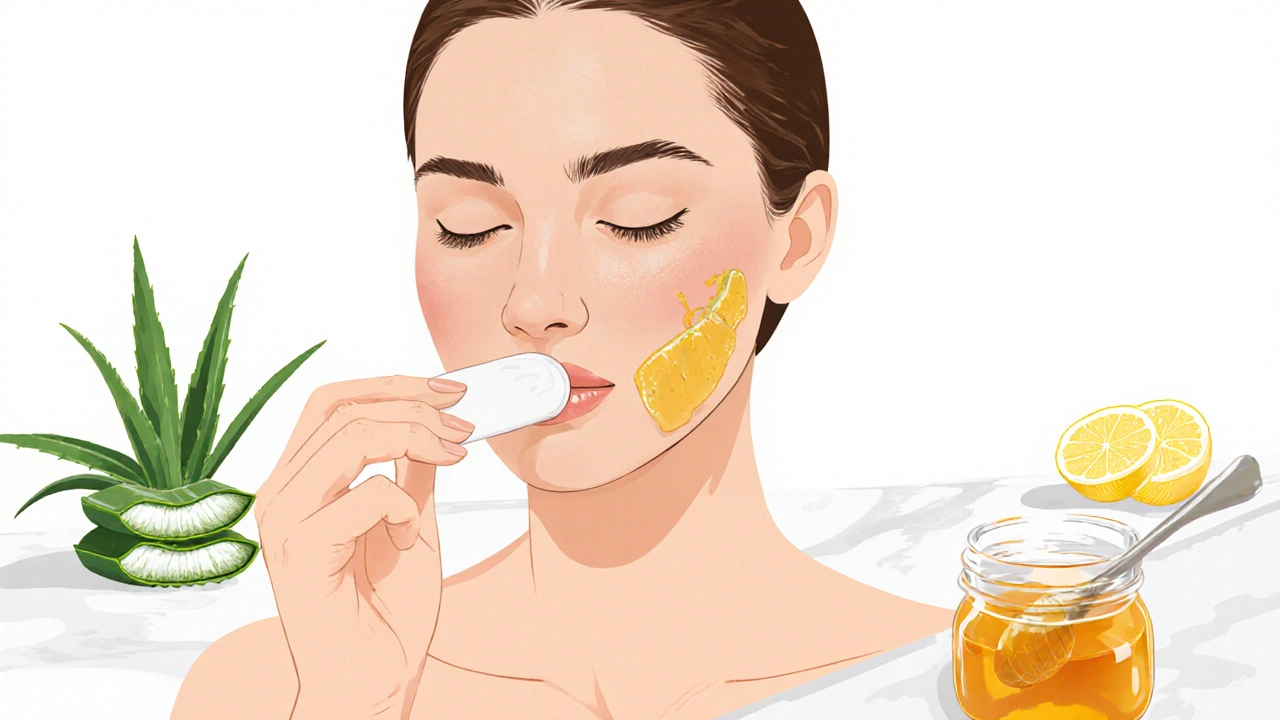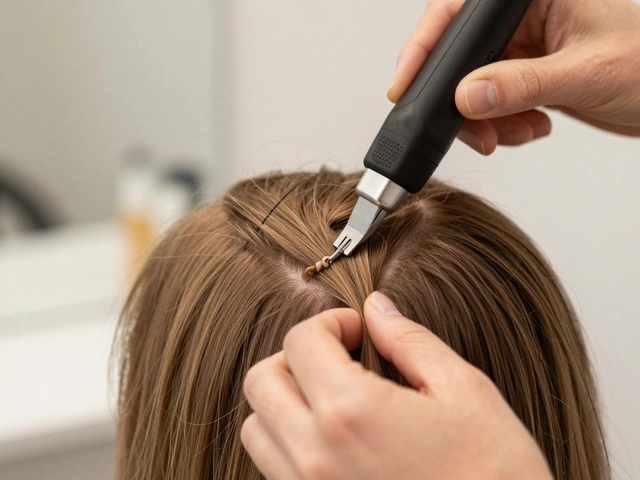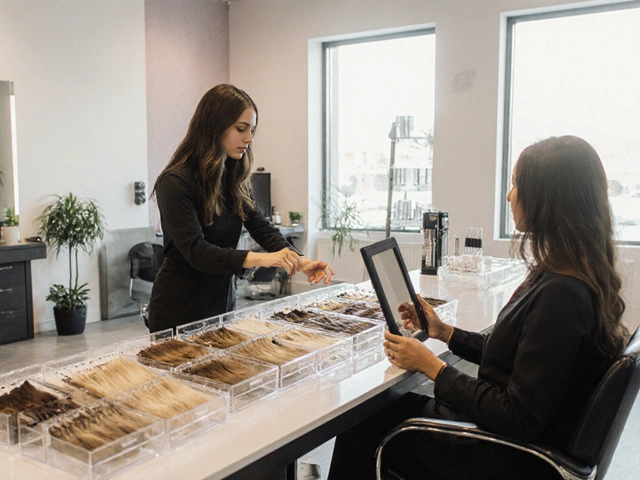Honey wax hair removal is a natural method of removing unwanted hair using a paste made mostly from honey, sugar, and lemon juice. Unlike traditional wax that contains resins and chemicals, honey wax sticks to hair but not skin, making it gentler on sensitive areas like the face, underarms, and bikini line. It’s been used for centuries across cultures-from ancient Egypt to rural India-and today, it’s making a comeback as people look for cleaner, less irritating beauty routines.
How Honey Wax Works
Honey wax isn’t actually made from beeswax. Despite the name, most recipes use raw honey as the main ingredient because of its natural adhesive properties, moisture-retaining ability, and antibacterial qualities. When mixed with sugar and a bit of lemon juice, it forms a sticky, pliable paste that hardens as it cools. You apply it warm (not hot) in the direction of hair growth, press a cloth strip on top, then pull it off quickly against the grain. The wax grips the hair shaft close to the root and yanks it out cleanly.
Unlike paraffin-based waxes that can stick to the skin and cause redness or peeling, honey wax adheres primarily to the hair. This means less pain and fewer side effects for most people. A 2023 study from the Journal of Cosmetic Dermatology found that users reported 40% less irritation with honey-based wax compared to traditional strip wax after four consecutive treatments.
Why People Choose Honey Wax Over Regular Wax
There are clear differences between honey wax and store-bought wax strips or salon hard wax:
- No synthetic chemicals - Honey wax contains no petroleum derivatives, resins, or artificial fragrances.
- Moisturizing - Honey naturally draws moisture into the skin, so your skin feels softer after waxing.
- Antibacterial - Raw honey has natural enzymes that help prevent ingrown hairs and reduce the risk of infection.
- Biodegradable - You can wash it down the drain without clogging pipes or harming the environment.
- Cost-effective - A jar of honey, a cup of sugar, and a lemon cost less than $5 and make enough wax for 5-10 sessions.
Regular wax, on the other hand, often contains colophony (pine resin), paraffin, and preservatives. These can trigger allergic reactions in people with sensitive skin. Some salon waxes even include synthetic dyes and perfumes that add no benefit-just extra risk.
What You Need to Make Honey Wax at Home
Making honey wax at home takes five minutes and zero special tools. Here’s what you need:
- 1 cup raw, unfiltered honey (not processed or pasteurized)
- ½ cup granulated white sugar
- 1 tablespoon fresh lemon juice (acts as a natural preservative and helps with viscosity)
- A silicone spatula or wooden spoon
- A microwave-safe bowl or double boiler
- Cotton strips or reusable cloth pieces (about 2 inches wide and 6 inches long)
Combine all ingredients in a bowl and heat gently until the sugar dissolves and the mixture turns amber-colored (about 3-5 minutes on medium heat). Don’t boil it. You want it thick enough to hold its shape when cooled slightly-not runny, not rock-hard. Let it cool for 10-15 minutes until it’s warm to the touch, like honey on toast.
How to Use Honey Wax Safely
Follow these steps to avoid burns, irritation, or broken skin:
- Wash and dry the area thoroughly. Oils or sweat can prevent the wax from sticking properly.
- Apply a light dusting of cornstarch or baby powder to reduce friction and help the wax grip hair, not skin.
- Spread the wax in the direction of hair growth, using a thin, even layer-about the thickness of a credit card.
- Press a cloth strip firmly over the wax and smooth it down with your fingers.
- Hold the skin taut with one hand and pull the strip off quickly in the opposite direction of hair growth.
- Repeat until the area is clear. Don’t reapply wax to the same spot more than twice.
- After waxing, rinse with cool water and apply aloe vera gel or coconut oil to soothe the skin.
Never use honey wax on sunburned skin, open wounds, or areas with active acne or rosacea. And if you’ve used retinoids or chemical peels in the last 48 hours, skip waxing-your skin will be too thin and vulnerable.

How Long Does Honey Wax Last?
Honey wax removes hair from the root, so results last about 3 to 6 weeks, depending on your hair growth cycle. Most people notice slower regrowth after 3-4 sessions because repeated waxing weakens the hair follicle over time. Some users report finer, lighter hair returning after consistent use-especially in areas like the upper lip or chin.
Compared to shaving, which needs repeating every 2-3 days, honey wax saves time and reduces stubble. Unlike laser hair removal, it doesn’t require multiple expensive sessions or special equipment. It’s a middle ground between quick fixes and permanent solutions.
Who Should Avoid Honey Wax?
While honey wax is gentle for most, it’s not for everyone:
- People with severe bee allergies-yes, even though it’s not beeswax, raw honey contains trace pollen and proteins that can trigger reactions.
- Those with diabetes or poor circulation-slower healing increases risk of infection.
- Anyone using blood thinners or topical steroids-these make skin more fragile.
- Children under 12-skin is too delicate and sensitive to handle the pulling motion.
If you’ve never tried waxing before, test a small patch on your inner forearm first. Wait 24 hours. If there’s no redness, itching, or swelling, you’re likely safe to proceed.
Where to Buy Pre-Made Honey Wax
If you don’t want to make your own, several brands offer ready-to-use honey wax kits. Look for products labeled “100% natural,” “no additives,” and “raw honey-based.” Popular options include:
- GiGi Honey Wax - A widely available brand with a smooth texture and mild scent.
- Blu Wax Honey Formula - Designed for sensitive skin and often used by estheticians.
- Veet Honey & Aloe Wax Strips - Convenient pre-coated strips, though less effective than warm wax.
Avoid products that list “beeswax” as the first ingredient unless they also contain honey and sugar. True honey wax is water-soluble and easy to clean up. Beeswax-based products are harder to remove and often require oil or special removers.

Aftercare Tips for Softer Skin
What you do after waxing matters just as much as how you apply the wax. Here’s what works:
- Wait 24 hours before applying deodorant, perfume, or tight clothing to the area.
- Exfoliate gently every 2-3 days using a soft brush or sugar scrub to prevent ingrown hairs.
- Keep the skin hydrated with fragrance-free moisturizers-honey wax leaves skin dry, so it needs help.
- Wear loose cotton clothes for the first day to reduce friction.
- Don’t pick at hairs that are still growing in. Let them come out naturally.
Many users report that after 2-3 months of weekly or biweekly honey waxing, their skin becomes noticeably smoother and less prone to bumps. Some say they’ve stopped using lotions altogether because their skin feels naturally hydrated.
Myths About Honey Wax Debunked
There’s a lot of misinformation out there. Let’s clear it up:
- Myth: Honey wax is only for facial hair. Truth: It works great on legs, arms, underarms, and even the bikini line. Just adjust the temperature for thicker hair.
- Myth: It’s more painful than regular wax. Truth: Most people find it less painful because it doesn’t stick to skin as much.
- Myth: You need special equipment. Truth: A microwave, a bowl, and a spoon are all you need.
- Myth: It’s messy and hard to clean. Truth: Honey wax washes off with warm water. No solvents needed.
One woman in Asheville, who’s been using honey wax for five years, told me she switched after a bad reaction to a salon wax. “My legs used to look like a rash map for days. Now, I do it myself every three weeks and my skin looks better than when I was a teenager.”
Final Thoughts: Is Honey Wax Worth It?
If you’re tired of razors that nick your skin, chemical depilatories that burn, or expensive laser treatments, honey wax is a smart, natural alternative. It’s affordable, effective, and gentle enough for regular use. You don’t need to be a beauty expert to do it right-just patient and careful.
Start small. Try your upper lip or underarms first. Once you get the hang of it, you’ll wonder why you waited so long. Your skin will thank you-for being cleaner, smoother, and free of harsh chemicals.
Is honey wax better than sugar wax?
Honey wax and sugar wax are very similar-both are natural, water-soluble, and gentle. The main difference is that honey wax has antibacterial and moisturizing properties thanks to honey, while sugar wax is just sugar, water, and lemon. Honey wax tends to be stickier and better for fine hair, while sugar wax is easier to make and less expensive. Many people mix them for the best of both worlds.
Can I use honey wax on my eyebrows?
Yes, honey wax is excellent for eyebrows. It’s precise, less irritating than threading, and doesn’t tug on delicate skin around the eyes. Use a small amount and apply in thin layers. Always test the temperature on your wrist first. Many estheticians prefer honey wax for shaping brows because it removes hair cleanly without leaving redness.
How long does homemade honey wax last?
Stored in an airtight container at room temperature, homemade honey wax lasts about 2-3 months. If you notice it separating or smelling off, toss it. For longer storage, keep it in the fridge for up to 6 months. Reheat gently before use-don’t microwave it too long or it’ll burn.
Does honey wax cause ingrown hairs?
It’s actually one of the least likely methods to cause ingrown hairs. Honey’s natural enzymes help prevent bacteria buildup, and the way it pulls hair out reduces breakage. Still, exfoliating 2-3 times a week after waxing helps keep pores clear. If you do get ingrowns, apply tea tree oil diluted with water-it reduces inflammation fast.
Can I use honey wax if I’m pregnant?
Yes, honey wax is generally safe during pregnancy. Hormonal changes can make skin more sensitive, so test a small area first. Avoid waxing the bikini line if you’re prone to varicose veins or swelling. Always consult your doctor if you have any concerns about skin changes or allergies.







Vishal Bharadwaj
November 10, 2025 AT 16:43anoushka singh
November 10, 2025 AT 22:40Jitendra Singh
November 11, 2025 AT 19:23Madhuri Pujari
November 12, 2025 AT 02:09Sandeepan Gupta
November 12, 2025 AT 19:01Tarun nahata
November 14, 2025 AT 17:15Aryan Jain
November 16, 2025 AT 15:02Nalini Venugopal
November 17, 2025 AT 00:49Pramod Usdadiya
November 17, 2025 AT 13:33Aditya Singh Bisht
November 19, 2025 AT 08:09Agni Saucedo Medel
November 19, 2025 AT 10:14ANAND BHUSHAN
November 20, 2025 AT 05:33Indi s
November 21, 2025 AT 17:35Rohit Sen
November 22, 2025 AT 07:20